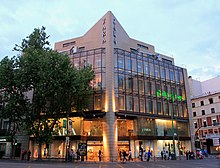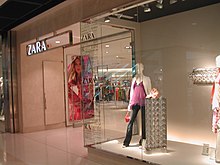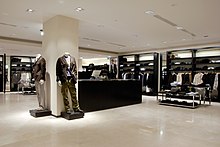Zara (company)
| Zara
|
|
|---|---|
| legal form | Sociedad Anónima (SA) |
| founding | 1975 |
| Seat |
Arteixo , Spain |
| management | Pablo Isla Álvarez de Tejera |
| Number of employees | 171,839 Inditex (2017) |
| sales | € 16.62 billion (2017) |
| Branch | Textile retail |
| Website | www.zara.com |
| Status: 2017 | |
Zara [ ˈθaɾa ] is a textile company that sells inexpensive clothing , accessories and shoes for women, men and children worldwide through its own network of retail outlets and an online shop . Zara is the best-known production and sales chain of the listed Spanish Inditex group founded by Amancio Ortega and Rosalía Mera .
In 2010, Zara had around 25,000 employees worldwide and around 1,763 branches in 86 countries on four continents, including around 275 in Spain. In 2015, the parent company Inditex achieved sales of 20.9 billion euros. Of these, Zara accounted for 13.6. In 2016, Zara generated sales of around 15.4 billion euros with a total of 2,213 branches worldwide.
history
The first Zara store opened in A Coruña ( Spain ) in 1975 . After the successful start, Zara expanded in the Spanish-speaking area and established a network in other Spanish cities. In 1980 the first store was opened in Portugal. The first stores opened in the United States in the 1990s.

The go-ahead for Zara Deutschland GmbH was given on October 19, 1999 with the opening of the first branch in Cologne. The branch in Hamburg followed on December 2, 1999. As of 2010, Zara Germany had 64 over-the-counter stores in 45 cities. In April 2014, Zara opened a branch in Bremen.
The Tagesspiegel reported on April 18, 2006 that Zara had replaced Hennes & Mauritz (H&M) as the company with the highest turnover in the division with a sales increase of 21 percent to 6.74 billion euros .
At the end of 2005 and beginning of 2006, Inditex changed its business strategy and dissolved the existing joint ventures relating to Zara in Italy and Japan; each company took over 100 percent.
Zara Deutschland GmbH was at times a joint venture between Inditex and the German Otto group. Initially operated in equal shares, Inditex has taken over the majority. In 2006 Otto sold 28 of his 50 percent to Zara. In 2010, the Otto Group sold its last 22% stake.
In August 2014, the company hit the headlines because of a black and white striped children's shirt with a yellow star, which reminded many of the prisoners' clothing of concentration camp inmates.
concept


Zara produces and sells fashionable clothing, accessories and shoes for women, men and children that can only be bought in its own stores (sometimes shops-in-shops in larger department stores) and via its own online shop. The adult range is basically aimed at a young, fashionable target group. The commodity prices are in the low to lower middle price segment. In contrast to other retail chains, Zara manufactures a large part of its goods in its own production facilities in European countries such as Spain, Portugal or Turkey.
The business concept is based on reacting very quickly to developments in international fashion and very frequently bringing new models or lines into the shops. This is why so-called “trend scouts” from Zara observed the fashion world at trade fairs, in shops, on the street and at social events. The chain employs more than 200 fashion designers. The clothing is sold exclusively in its own stores, which are usually in attractive locations in city centers and shopping malls, since window and shop decorations are the only form of advertising used.
Zara allegedly advertises its goods less via print , radio or television , which is said to go back to the company's founder Amancio Ortega, who regards advertising as meaningless. Merely the advertising in the shop window is enough to attract customers. However, there are certainly advertising campaigns with models , some of which are internationally known , which can be seen in the shops and on the website. The core is based on building a big brand without the marketing efforts exceeding the actual target market.
Collections
- Zara Woman - main collection for women
- Zara Studio - sub-collection for women with unusual cuts and high-quality materials
- Zara Man - main collection for men
- Zara TRF (short for: "Trafaluc") - cheaper second line for women for the younger target group from teenage years
- Zara Basic - sub-collection for women and men with basic garments
- Zara Kids - children's fashion for newborns to teenagers
- Zara Kids Studio - sub-collection for children with unusual cuts
- Zara Home - home collection with home accessories
criticism
Critics complain that the founder, Amancio Ortega, is one of the richest men in the world, but at the same time his company exploits its textile workers and, according to Greenpeace, is highly polluting.
Change of corporate form
In August 2010, the Verdi union criticized Zara because Zara Deutschland GmbH had been converted into a company under Dutch law, but the company had not informed the works council of the German subsidiary. Zara is no longer obliged to fill half of the Supervisory Board with employee representatives.
Inhuman working conditions and allegations of child labor
Zara has repeatedly been shown that many of their production facilities have to work under inhumane conditions. In mid-2011, investigations into suspected forced labor against Zara began in Brazil . The Brazilian Ministry of Labor says it has fined Zara more than 50 times for numerous violations. In 2016, BBC News reported that several factories in Turkey that produced for Zara employed Syrian refugees below the Turkish minimum wage as well as children. Zara then announced that various 'deficiencies' were discovered in June 2016 and that these should be remedied in Dec. 2016 - that is, six months later
Blacklists
According to reports from the Ver.di trade union in May 2019, the group keeps blacklists of undesirable employees in Germany . Works councils and mothers are highlighted in red.
Carcinogenic ingredients
Greenpeace has examined garments for harmful components and has found what they are looking for in all branded articles. These contained nonylphenol ethoxylates (NPE), which are broken down into toxic nonylphenols . The highest levels of NPE were found in garments from Zara, C&A , Calvin Klein, and others. In addition, children's jackets and jeans from the Zara brand contain hormonally active and carcinogenic chemicals .
Tax avoidance
Inditex and Zara have come under fire because the group of companies - like numerous other multinational corporations - tries to minimize its tax payments by shifting profits . Over the past five years, Inditex has accounted for $ 2 billion in profits through smaller subsidiaries in Switzerland and the Netherlands. Although only 0.1 percent of the group's employees are employed there, almost 20 percent of the global profit was taxed there.
Racism & anti-Semitism allegations
The fashion label caused outrage several times with questionable designs, for example with swastika motifs on a handbag, a children's shirt in the style of a concentration camp uniform with a Jewish star or the slogan "White is the new black".
Web links
- Official website of Zara
Individual evidence
- ↑ a b c Inditex Annual Report 2017. (PDF) Retrieved on October 6, 2018 (English).
- ↑ Sales of Zara worldwide by 2015 | Statistics. Retrieved January 23, 2017 .
- ↑ ZARA - Who we are - Timeline ( Memento from February 16, 2011 in the Internet Archive ), accessed: January 12, 2011.
- ↑ Zara optimizes locations and plans new branches de.fashionmag.com, on April 23, 2009.
- ↑ WESER-KURIER: Zara in Bremen is open
- ↑ Tanja Kewes: Turning away from the tailoring of the world. In: Der Tagesspiegel. April 18, 2006.
- ↑ Two market leaders, one goal: Zara Deutschland GmbH remains a joint venture between Inditex and the Otto Group - ottogroup on March 22, 2006 ( Memento from February 11, 2012 in the Internet Archive )
- ↑ Otto separates from Zara ( Memento from April 2, 2015 in the Internet Archive ), Süddeutsche Zeitung from August 9, 2010.
- ↑ Jonas Jansen: Zara destroys T-shirts with a concentration camp look. In: FAZ.net . August 27, 2014, accessed October 13, 2018 .
- ↑ lesmads.com: Fall 2011: Stella Tennant and Hailey Clauson for Zara , August 3, 2011.
- ^ Zara, a Spanish success story ( Memento from October 1, 2009 in the Internet Archive ) 15. June 2001.
- ↑ cnbc.com
- ↑ huffingtonpost.de
- ↑ rtl.de
- ↑ greenpeace.de
- ↑ Verdi criticizes the textile chain Zara , haz.de, August 9, 2010, accessed on March 11, 2014.
- ↑ forbes.com: Zara Accused Of Alleged 'Slave Labor' In Brazil (English)
- ↑ Disastrous working conditions. Do forced laborers create for Zara? , n-tv.de, August 18, 2011, accessed on August 18, 2011.
- ↑ bbc.com
- ↑ huffingtonpost.de
- ↑ Fashion chain Zara maintains internal blacklists of employees , Thüringer Allgemeine , May 23, 2019
- ↑ Marion Lühring: The list that scares: Blacklist in Munich branch: mothers for future terminations listed , ver.di Publik 04/2019, p 4
- ↑ Greenpeace Germany: The toxic scam of fashion brands ( Memento from June 22, 2013 in the Internet Archive ), on November 20, 2012.
- ↑ Ortega's Zara Fashions Tax Avoidance by Shifting Profits to Alps ( Memento from March 2, 2014 in the Internet Archive )
- ^ Scandal at Zara: "Judenstern" and swastikas tagesspiegel.de, in August 2014.
